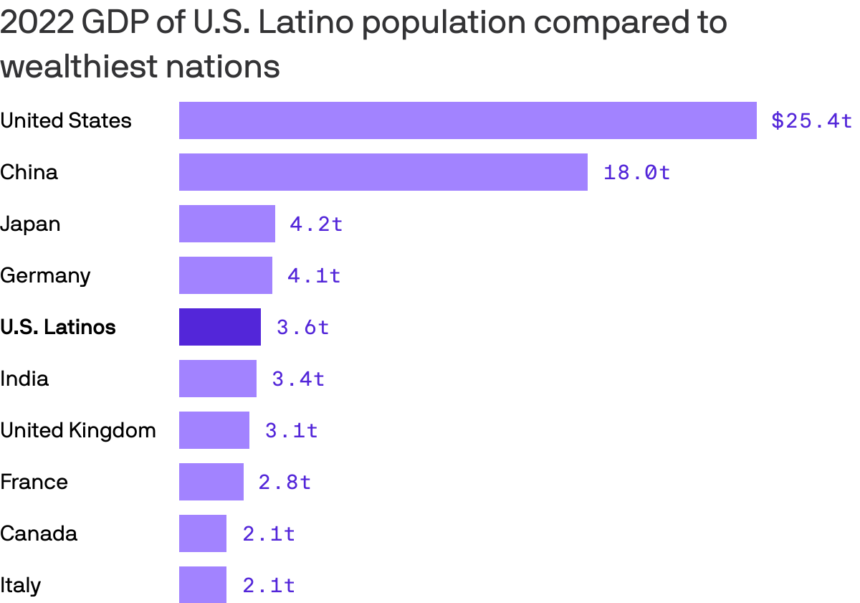The total economic output of U.S. Latinos reached $3.6 trillion in 2022, growing at a faster rate than most wealthy global economies, according to a report released Thursday.
Why it matters: Despite wide economic disparities in the United States, Latinos’ rapid population growth, relative youth, educational attainment and high levels of entrepreneurship have made them an economic powerhouse.
By the numbers: If U.S. Hispanics were an independent country, they’d have the 5th largest economy in the world for the second consecutive year, according to a report from the Latino Donor Collaborative (LDC), a non-profit organization researching Latino issues.
- The Latino GDP inched closer to Germany’s in 2022, the latest available data. It stayed ahead of the United Kingdom, India and France, even as those economies grew.
- Between 2017 and 2022, Latinos’ GDP growth trailed only that of China, seeing a 4.6% annual average real growth rate compared to China’s 5.3%.
Zoom in: The five states where Latinos had the greatest economic output in 2022 were California ($935.2 billion), Texas ($686.6 billion), Florida ($347.8 billion), New York ($268 billion), and Illinois ($125 billion), per the LDC study.
- The size of the 10 largest Latino economies grew faster than their non-Latino counterparts between 2017 and 2022.
- In 2022, manufacturing was the biggest driver of U.S. Latino economic growth, which reached $457.4 billion, a 48.4% year-over-year increase.
Stunning stat: Between 2017 and 2022, the growth in the share of U.S. Latino high-income earners (individuals with incomes in the 95th percentile or above) outpaced that of non-Latinos by a factor of six.
The intrigue: Another U.S. Latino GDP report, released Monday by researchers from UCLA and California Lutheran University, found that, from 2019 to 2022, Latinos were responsible for 41% of the growth in real U.S. GDP despite comprising just 19% of the U.S. population.
Yes, but: About 17% of all U.S. Latinos live in poverty — well above the nation’s overall poverty rate of 12.5%, based on the Census Bureau’s 2022 5-year estimates.
- An Axios review found that ten of the country’s communities with the largest share of Latino residents have a poverty rate that’s 50% higher than the national average.
What they’re saying: Tackling those poverty rates will help the Latino GDP grow even more, but financial institutions need to do their part, Patty Juarez, Wells Fargo EVP and Head of Hispanic and Latino Affairs, tells Axios.
- Juarez says Wells Fargo reaches out to “unbanked” potential Latino customers and offers counseling to help Hispanic residents improve credit scores to buy homes.
- “We want to help out all Latinos, not just successful Latinos.”
What we’re watching: The U.S. Latino economy is expected to surpass Japan’s economy by 2024 and Germany’s by 2027.
- It could be outranked by India in 2026, making it the fourth-largest economy by 2029.
Subscribe to Axios Latino to get vital news about Latinos and Latin America, delivered to your inbox on Tuesdays and Thursdays.











